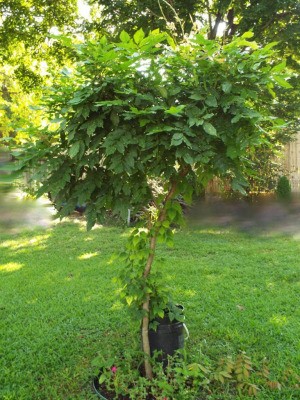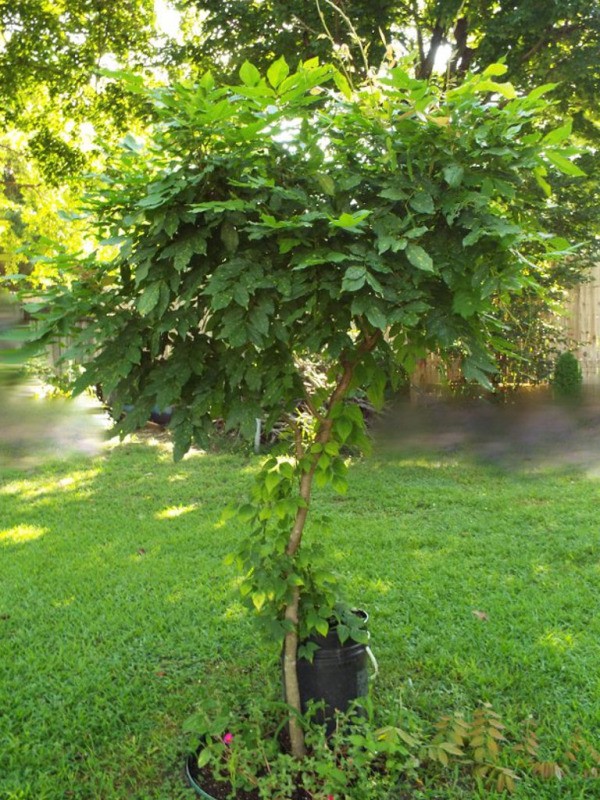 As is everything else, the wisteria is a program. This program make a wisteria vine. (Technically, wisteria is a bine, not a vine, and of course this program expresses itself as a bine).
As is everything else, the wisteria is a program. This program make a wisteria vine. (Technically, wisteria is a bine, not a vine, and of course this program expresses itself as a bine).
It will require 'maintainance pruning' during the growing season for as long as you own the plant. Though not difficult to do, it is an ongoing thing and should be taken into consideration when choosing whether to to grow a wisteria as a standard.
In an effort to 'send out runners', the wisteria produces sprouts at the top of the 'tree'.

These sprouts often grow as much as a foot, overnight. Left unchecked, they will quickly grow to several feet. Dropping to the ground, they will continue to grow rapidly and begin searching for a tree or other object to climb. To maintain a tree form, these sprouts must be removed, sometimes as often as every day during the growing season. They should be cut or broken back to where they meet older growth.
The wisteria program has another set of instructions to insure it will find something to climb and give it support. This 'extra insurance' is in place because the wisteria often begins in shady, wooded areas. It must climb tall objects where its terminal leaves will be exposed to the full sunlight necessary for optimal growth.
So, at ground level and at the base of its trunk, the wisteria produces more runners.

Though not as numerous as the sprouts at the top, they grow much more rapidly, sometimes as much as 2 feet, overnight. These too must be kept in check, being severed from the trunk as they are noticed.
There is a third way to prune a wisteria standard, though it is not done to maintain a tree form. For unknown reasons, the wisteria standard will sometimes refuse to bloom. Inserting a spade into the ground, in a circle around the tree at its drip line for the depth of a foot will sever many fine roots. This severing stimulates the tree to produce blooms the following year.
The 5 gallon bucket beneath the canopy of the pictured wisteria is part of a trial. It contains a Vigna Caracalla (Corkscrew) vine. Rather than have this vine take over my entire clothes line, I'm experimenting to see how well the vine will grow to the top of the wisteria and then wrap itself continuously around the tree top.
So far, my experiment is working very well. If the Vigna will stay near the outer portions of the tree, there should a fabulous display of Vigna blooms hanging about the wisteria tree top later this season. I'm keeping my fingers crossed.
This is really interesting. I love wisteria but have only grown it on a back fence due to the fast growth but it is beautiful so it would be nice to have it other places.
I have a Wisteria that I planted about 20 years ago. I kept cutting it back as it took over a wooden trellis and broke into pieces twisting around it. That Wisteria died or so I thought of a root rot disease. I planted other things there and about 10 years ago, the Wisteria came up again about 5 feet away from its original spot. It is growing like crazy and I would like to have a tree form too. I have an Olive tree that is huge and the wisteria found it and climbed all over it, but I cut it back as I thought it would damage my olive tree. You are right about it growing so fast. It is now trying to attach to the snowball bush but I am going to cut it back. I just want it to stay in its own space but it doesn't want to.
I think you would find taking master gardener classes very rewarding.
What I find most interesting about plant life (as well as all life) is its inherent tenacity and will to survive and procreate. The same engine that drives the Universe compels the tiniest flower to lift its head and burst forth its seed.
It does seem they can be a lot of trouble. But that beautiful Spring display makes it all worth it.